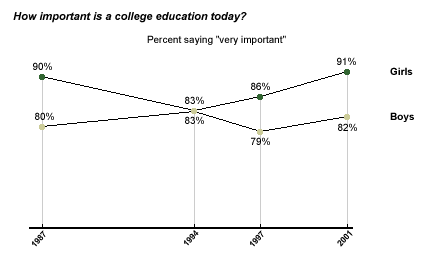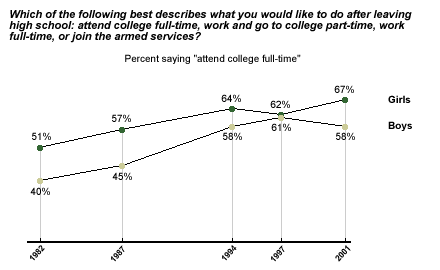Note to Title IX detractors: you may want to rethink your position. In the future, it may be what saves your alma mater's football program.
How can that be? Title IX, which guarantees equal educational opportunities to male and female students, has been criticized for diverting resources from more popular male-dominated sports to less well-attended athletic programs geared for females. But that situation could change radically as women continue to outnumber men on campus in steadily increasing numbers.
It took nearly a century for women's postsecondary graduation rates to catch up with men's. In 1900, women earned fewer than 20% of all undergraduate degrees. That number rose to 40% by 1930, but men and women didn't reach parity until the 1980s. In the last 20 years or so, however, women have been earning undergraduate and master's degrees in greater numbers than men. According to the National Center for Education Statistics, women earned 57% of all degrees conferred in the 1999-2000 academic year. Men still received a majority of doctoral and first-professional degrees that year, 56% and 55%, respectively.
College by the Numbers
This disparity has created a minor controversy. Many educators and education critics are wondering whether men are getting educationally short-changed. But Gallup Youth Survey* results suggest that even before reaching college age, boys and girls view the importance of a college education differently. When Gallup asks teens (aged 13 to 17) "How important is a college education today?" girls are usually more likely than boys to say "very important." With the exception of 1994 (when 83% of both girls and boys answered "very important"), girls outnumbered boys with this response by at least seven percentage points each year that the question was asked since 1987.

Girls are also more apt to plan to go to college full time than are boys, and they have been for some time. In 1982, Gallup began asking "Which of the following best describes what you would like to do after leaving high school: attend college full-time, work and go to college part-time, work full-time, or join the armed services?" That year, 51% of girls and 40% of boys planned to go to college full time. The gap widened even farther in 1987, then narrowed in the 1990s, and widened again in 2001.

A Step Ahead in the Paper Chase
So why are men outpaced by women in the paper chase? It's possible that women are more motivated to earn degrees. Or it's possible that women have had many more role models in academia -- all those women teachers from kindergarten through high school (see "Male Role Models Missing From the Classroom" in Also This Week.). Perhaps men feel that they can find lucrative careers in traditionally male-dominated fields like plumbing, carpentry and auto mechanics, which don't require four-year degrees.
Or maybe women are just innately better students, as some educators have claimed. Dr. Anne Leavitt, the vice president of student affairs at the University of Oregon, says that, "Even in high school, it's the girls who are apt to ask for help. They're the ones who would come in early and stay after school to talk to teachers. In college, when we see incoming students with habits of relying on the helping community, we know they get a much stronger start. They have linked the need to learn with helpers."
So, more girls than boys think college is important. More girls than boys plan to go to college. And years later, more women than men earn bachelor's and master's degrees. What about the football programs? Leavitt has some words of advice on that topic, too. "Coaches can be role models for a lot more than just sports. They help athletes get used to mentors -- and maybe that will help men ask for help."
Key Points
For the first time since American soldiers were fighting in World War II, more women than men are earning bachelor's and master's degrees at U.S. colleges. High school girls are a little more likely to think college is "very important," and are more likely to plan to go to college than are boys. This trend has significant implications for recruiting in the business world, and for recruitment and curriculum planning at high schools and colleges. Finally, in order to help boys reach educational parity, parents and teachers may need to encourage them to build "helping" relationships -- there is evidence that boys who find mentors and other forms of assistance have a stronger start in college.
*Findings are based on telephone surveys of approximately 500 American teen-agers, aged 13 to 17, conducted in 2001. For results based on this total sample, one can say with 95% confidence that the maximum error attributable to sampling and other random effects is ±5%.